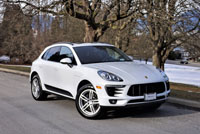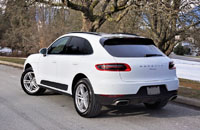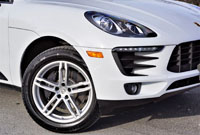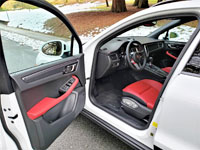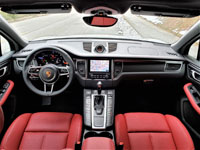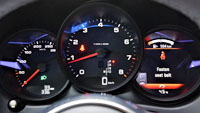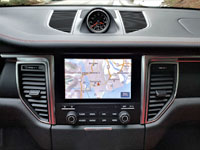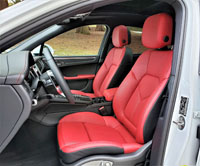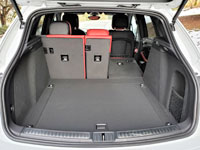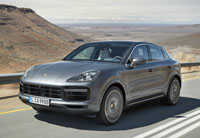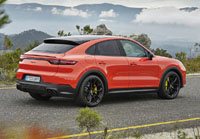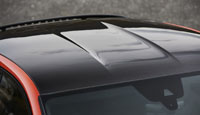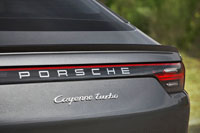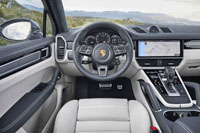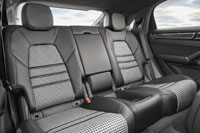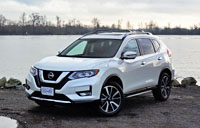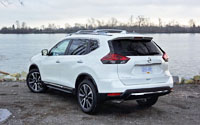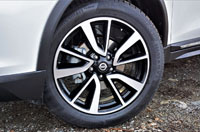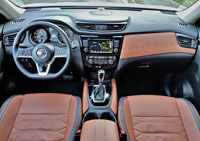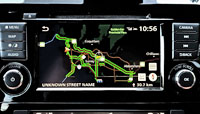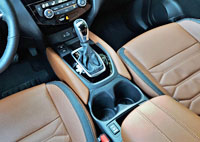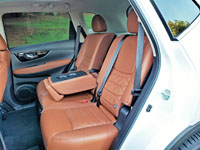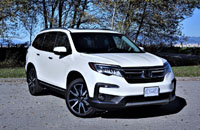
Other than a few unusual offerings like the Element, Crosstour, and current Civic Hatchback/R, Honda’s styling normally resides in the conservative camp, and when it comes to mid-cycle makeovers that conservatism is downright mossbacked. Still, despite mere evolutionary changes made from the 2016-2018 third-generation Pilot to the latest iteration, introduced last year for 2019, it looks a lot better than it used to.
It starts a more aggressive looking traditional SUV-type grille above a bolder front bumper and fascia, all of which are bookended by beautiful new trademark full LED headlamps in my tester’s top-tier Touring trim line. By the way, all Pilots now come with LED headlights, but those lower down the desirability scale only incorporate LEDs within their low beams and therefore appear more conventional when put side-by-side with the vertical elements inside the Touring model’s more sophisticated looking full LEDs.
When viewed from the rear, new LED taillights are standard across the entire Pilot line, plus a new rear bumper incorporates the same satin-silver-coloured skid plates as those up front, with most trims. Of note, both the base Pilot and Canada-exclusive Black Edition get black skid plates front to rear, albeit the former are matte finished and the latter glossy black. Speaking of trim highlights, the Touring model features chromed door handles and sporty new 20-inch alloy wheels, helping to make it much more upscale than other trims in the lineup, and plenty attractive when placed beside its mid-size crossover SUV peers.
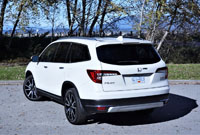
Along with the refresh, Honda made some important mechanical changes to help refine Touring and Black Edition models, particularly by revising their standard auto start-stop system, making it turn off and restart the engine faster and smoother. This upgrade will hopefully cause owners to keep the start-stop system engaged, which will certainly help improve fuel economy and reduce emissions. I certainly never experienced any problems with the system throughout my weeklong test drive, in fact hardly noticing its operation at all.
Additionally, Honda reportedly refined the two top models’ standard nine-speed automatic transmission, which, like the auto start/stop system, worked perfectly throughout my test week. In fact, I’d go so far as to say it’s better than ever, providing truly smooth and effortless shifts when both driving in the city and operating at highway speeds, while also downshifting with nice, quick, snappy precision when performing passing maneuvers. Owners of lesser Pilot trims, which include the base LX plus mid-range EX and EX-L Navi models, get a very well-proven six-speed automatic transmission, which remains unchanged moving into 2019.
Unlike the Pilot’s gearbox duality, all trim levels incorporate one single 24-valve, SOHC 3.5-litre V6 engine, which despite having already served Honda well for more than a decade, other than small updates, continues to make a potent combination of 280 horsepower and 262 lb-ft of torque, thanks in part to direct-injection and i-VTEC, while its Active Control Engine Mount (ACM) system aids refinement further by reducing noise, vibration and harshness.
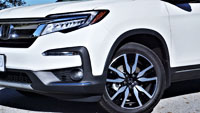
Also standard, all Canadian-spec Pilots include Honda’s Intelligent Variable Torque Management (i-VTM4) AWD, which together with the Japanese brand’s Intelligent Traction Management System, helps provide immediate grip at takeoff for smooth yet quick response. What’s more, this energetic straight-line performance was enhanced by a fully independent suspension that felt nimbler through quick corners, while its ride quality was completely comfortable all the time, only becoming slightly unsettled when I pushed it further than most owners would for testing purposes, and then only when the road below exposed crumbling, uneven pavement.
Truth be told, I don’t try to imitate Red Bull-Honda Racing F1 driver Max Verstappen all that often (but would love to have his skill), especially when piloting a large SUV, but normally apply available eco modes before keeping to a more moderate pace. Such practices are rewarding with the Pilot, thanks to the auto start/stop system mentioned before, plus the engine’s Variable Cylinder Management (VCM) system that shuts off a bank of cylinders under lighter loads to further improve fuel economy, my tester achieving a commendable 11.3 L/100km during my mostly flat city street test week, which is very close to Transport Canada’s estimated rating of 12.4 L/100km city, 9.3 highway and 11.0 combined. I haven’t driven the six-speed version since it was the only transmission offered in this SUV, prior to the third-gen redesign, so I can’t attest to its claimed rating of 13.0 L/100km city, 9.3 highway and 11.3 combined. Still, both sets of numbers are impressive when factoring in just how large this three-row SUV is.
I also didn’t test the Pilot with a trailer in tow, but Honda claims that both transmissions equal the same 1,588 kilograms (3,500 lbs) tow rating in standard guise, or 2,268 kg (5,000 lbs) with the upgraded towing package.
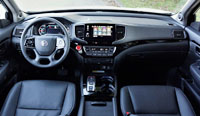
Now that I’m talking about moving gear, the Pilot has long been one of the more accommodating SUV’s in its class when it comes to luggage space. Behind the third row is a plentiful 524 litres (18.5 cubic feet), or 510 litres (18.0 cubic feet) with my Touring tester and the near identically equipped Black Edition. Lower that 60/40 split-folding third row down and cargo carrying capacity expands to 1,583 litres (55.9 cubic feet) no matter the trim level, while it available stowage space ranges from 3,072 to 3,092 litres (108.5 to 109.2 cubic feet) when all of its rear seatbacks are laid flat, but it’s important to note that a centre section of load floor is missing when equipped with second-row captain’s chairs. I like how some manufacturers attach a foldout carpeted extension to the back of one seat in order to remedy this problem, but no such luck with the Pilot. If this were mine, I’d keep a piece of plywood handy for hauling big loads.
On the positive the centre console isn’t so tall that it protrudes into the loading area, a problem with some luxury utes, but then again it’s barely raised above the floor, so will be a bit of a stretch for smaller occupants to reach when trying to use the cupholders. The good news is this console and the sliding/reclining captain’s chairs to each side aren’t standard with Touring trim (they are with the Black Edition), but instead replace a three-seat bench that ups total occupancy from seven to eight. The seating arrangement you choose will come down to the age/size of your kids or if you regularly bring adults along for the ride, because the rear captain’s chairs are definitely more comfortable than the outboard seats on the bench.
I won’t go into detail about the Black Edition in this review, but suffice to say it’s outfitted almost identically to seven-passenger Touring trim. As for my $52,690 Touring tester, it list of standard items includes the full LED headlamps noted earlier, plus power-folding and auto-dimming sideview mirrors, blue ambient interior lighting, acoustic glass for the front windows, rain-sensing windshield wipers, a pushbutton gear selector, cooled front seats, a large panoramic glass sunroof, a superb 600-watt audio system featuring 11 speakers and a sub plus 5.1 Surround, a wireless device charger, a new Honda CabinTalk in-car PA (that really works), HondaLink Subscription Services, Wi-Fi, the “How much Farther?” application, rear entertainment, an HDMI input jack, a 115-volt household-style power outlet in back, blindspot monitoring, rear cross-traffic alert, plus more.
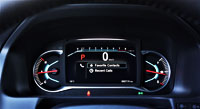
Features added to Touring trim from the lesser EX-L Navi model include an acoustic windshield, memory-linked side mirrors with reverse tilt-down, a heated steering wheel, a four-way power front passenger seat, a navigation system with detailed mapping, HD and satellite radio, front and rear parking sonar, heated outboard second-row seats, one-touch third-row access (that’s really easy to operate whether entering or trying to get out from the rearmost seat), second-row side window shades, a power liftgate, etcetera, while features sourced from the EX model include LED fog lamps, LED repeaters in the side mirror housings, roof rails, illuminated vanity mirrors, a Homelink universal remote, a leather-clad steering wheel, plus 10-way power and memory for the driver’s seat.
Finally, I need to also make mention of some standard LX features pulled up to Touring trim (the base Pilot LX starting at just $41,290), including remote engine start, proximity keyless entry, pushbutton start, a windshield de-icer, a conversation mirror that doubles for sunglasses storage, three-zone auto HVAC, heated front seats, HondaLink Assist Automatic Emergency Response System, etcetera (all prices are sourced right here on CarCostCanada, where you can also find all the latest rebate info as well as dealer invoice pricing that could save you thousands).
What’s more, each and ever Pilot gets a nice, big 7.0-inch TFT multi-information display within its primary gauge package, boasting attractive high-resolution colour graphics, simple operation via steering spoke-mounted switchgear, and plenty of useful functions, while over on the centre stack is an 8.0-inch fixed tablet-style touchscreen that’s even more comprehensively equipped with functionality. It gets a user-friendly multi-coloured tile design that looks as if it was inspired by Apple products, and fittingly includes Apple CarPlay, Android Auto, Bluetooth with streaming audio, a fabulous multi-angle rearview camera with dynamic guidelines, plus more.
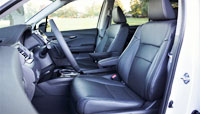
Honda also gives the Pilot a comprehensive list of standard advanced driver assistance systems (ADAS) including auto high beams, adaptive cruise control, Forward Collision Warning, Collision Mitigation Braking, Lane Departure Warning with Lane Keeping Assist, plus Road Departure Mitigation, which, when upgraded with Touring trim’s cornering low- and high-beam full LED headlamps, allows a best-possible Top Safety Pick + rating from the IIHS. Additionally, all Pilot trims earn a five-star safety rating from the NHTSA.
Just in case you’re starting to think that a team of publicity reps from Honda wrote this review, my weeklong test wasn’t wholly positive. For starters, even my top-line Pilot Touring tester wasn’t as impressively finished inside as some direct competitors, due to more hard plastic than I would have liked. Honda does cover the dash top in a soft synthetic, and adds a nice bolster across the instrument panel ahead of the front passenger, which extends above the centre touchscreen, while the front door uppers are also soft to the touch, ideal for pampering elbows, plus the door inserts and armrests are plush as well, of course, but oddly the door uppers in back aren’t as nicely finished, and Honda doesn’t wrap any roof pillars in cloth either, like some rivals do.
The seat upholstery is very upscale though, with driver’s perch particularly comfortable despite only providing two-way powered lumbar that didn’t fit the small of my back very well, and therefore remained unused by yours truly. Seats in mind, both second and third rows were very comfortable, the rearmost seating area even roomy enough for adults. I had ample legroom for my five-foot-eight frame, plus about three to four inches ahead of my knees when the second row was pulled rearward as far as it would go, and plenty of space overhead.
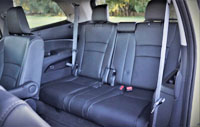
If you thought I was done griping, take note that I have issue with a foot-operated parking brake in a vehicle that does everything else to make a person think it’s been flown here from the future. Yes, this anachronism (I don’t like foot-operated parking brakes) flies in the face of one of the more advanced looking electronic gear selectors available on planet earth (standard with the nine-speed), so where is the electronic parking brake that should be attached? I’ll be waiting for Honda to solve this problem in an upcoming redesign, and remain unimpressed that it wasn’t dealt with sooner.
All of this complaining might cause a person to believe I’m not a fan of Honda’s updated Pilot, but this couldn’t be further from the truth. Yes, I’d like to see some changes made as noted, but such hopes for improvement hardly mean that the 2019 Pilot didn’t impress on the whole. In fact, I really enjoyed my time with Honda’s largest vehicle. It was a pleasure to drive, easy to live with, and nice to look at, exactly what is needed from a three-row family hauler.
Story credit: Trevor Hofmann
Photo credit: Karen Tuggay

